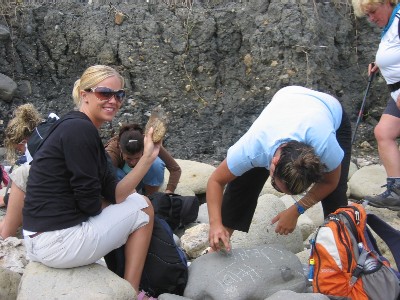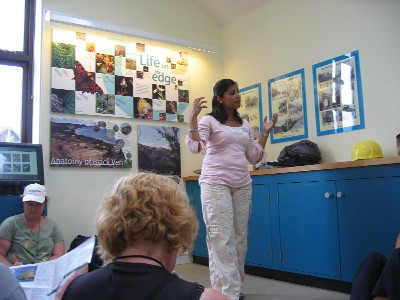The Real Jurassic Park: Geological Explorations in Southwest England
University of Washington, Tacoma
TESC 417: Summer 2006
The Real Jurassic Park: Geology field course along the south coast of England (TESC 417)
Home
Location: Charmouth
Introduction:
August 1, 2006--Charmouth is a small, quaint resort built on a steep hill which slopes down to a sandy beach and is famous for its fossil hunting and especially
for the well-known Mary Anning who found the first complete ichthyosaurus fossil in 1811. Although Mary lived in Lyme Regis, she also found many fossils in the Charmouth area. The town is located in West Dorset, just east of Lyme Regis.
Detail Map:

Highlights:
The beaches around Charmouth are some of the very best places to find fossils such as ammonites and belemnites.
For the seasoned fossil hunter, even bones from ichthyosaurs and extinct marine reptiles can be discovered. The cliffs are striking to look
at, but caution must be used as the cliffs are frequented by landslides. Black Ven, which is located between Charmouth and Lyme Regis, is the site
where the largest coastal landslide occured in Europe.
A World Heritage Visitor Center is located in Charmouth and guided tours of the area are available.
Synopsis of Area:
The rocks at Charmouth are from the Jurassic age and were laid down in a deep tropical sea, approximately 195 million years ago.
These rocks are composed of grey clays, shales and harder limestones. The layers of the beds of rock dip to the east and are clearly visible.
If you walk from Charmouth to Lyme Regis you will be walking through geological time--passing older and older rocks. On top of the cliffs are rocks from the Cretaceous age which are younger than the Jurassic rocks. These Cretaceous rocks were laid down about 100 million years ago in a shallow sea environment.
There is an unconformity between the Jurassic and Cretaceous rocks.
The Black Ven landslide sits between Charmouth and Lyme Regis. It is the most active mudslide in the UK. In the cliffs east of Lyme Regis to Charmouth there are very good sections of the Lower Jurassic Lias, mostly clays and shales with some carbonate beds. Church Cliffs is
immediately northeast of Lyme Regis.
 Jenny finds a fossil--and Heidi puts chalk to good use!
Jenny finds a fossil--and Heidi puts chalk to good use!
Summary:
The morning of August 1st was spent at Dinosaurland fossil museum. Then we were off to Charmouth via highway A3052. Our routine was to find the best
seat in the van (of course, there was no fighting, just a manic scramble to get the seat with the best view next to a van mate with the best snacks). With everyone
belted in, we were off for a fun afternoon on the coast.
 Dr. Anjana Khatwa, World Heritage Site education officer, speaks to the class
Dr. Anjana Khatwa, World Heritage Site education officer, speaks to the class
The topics of the day were paleontology and the World Heritage organization. We were fully inundated with information, not only from our knowledeable professors, but also from two well-versed guides.
We lunched on the floor of the visitor's center and were treated to a wonderful talk from Dr. Anjana Khatwa, a World Heritage Site education officer.
She educated us on the history of UNESCO (United Nations Educational, Scientific and Cultural Organization) which selects the World Heritage Sites. These
sites are chosen because of their outstanding universal value and are recognized as part of the hertiage of all mankind. The Dorset and East Devon Coast was given the World
Heritage designation in December 2001. Being given this status means that the designated sites should be conserved, protected and passed intact to future
generations. Such a designation not only protects the immedate site but also the towns and countryside that provide education and accommodations in the area.
After our talk, we had a chance to walk around the center and buy the things that tourists buy--T-shirts. Of course, these weren't just any T-shirts, they were
wonderfully bright colored shirts with images of ammonites on them. Everyone knows that only geology nerds buy this kind of sourvenir and we weren't above it.
Everyone looked great in their shirts and we could spot each other a mile away!
The afternoon was spent with the Charmouth ranger, Sam Scriven. First on the agenda was a slide show and talk on the paleontology at Charmouth. His introduction to
paleontology included a discussion on the Lower Jurassic climate, typical environments for a sheltered marine basin (Bituminous mud and restricted clays), major
fauna, terrestrial environments, trace fossils, and of course, our favorite--ammonites. After our talk, we took a hike (actually more like a mad dash) along the
beach, looking for fossils. We were thrilled to find many for the taking. In great abundance were the tiny belemnites which we enthusiastically gathered to
take back to loved ones (that way we could keep the T-shirts for ourselves). Since we were amateurs, we were slower to find the ammonites, that is, except
for Nels. He seemed to have a nack for zeroing in on these defenseless fossils and adding many to his bounty (I must add that he gladly shared with the rest of us).
Sam wasn't done with us yet. He suggested a nice hike up the hill to get a closer view of the cliffs. His idea of hiking was different from ours--he sprinted
up a vertical hill, leaving most of us struggling to catch up. The view was grand, we got a short rest and then a dash down the hill.
It had been a long day, our throats were dry and we were ready to head for a pub. However, we dutifully went to class first, discussed our finds and
what we had planned for the following day. Then we were off for the evening.
 Charmouth ranger, Sam Scriven, shares with the class
Charmouth ranger, Sam Scriven, shares with the class
Links to Related Projects:
Mary Anning: Paleontology's Enigmatic First Lady. By Raquel Eriz
Geology and Tourism on the South England Coast. By Jenny Ripatti
Holy Architecture!: Cathedrals, Abbeys, and Parish Churches of Southwest England. By Lisa Green
World Heritage: Conservation Efforts in the United Kingdom and Ireland. By Jeanine Riss
Geology, Landscapes, and Land Use of Dorset and East Devon. By Angus Leger
Other Related Links:
Geology of the Wessex Coast, Southern England by Ian West
References and Acknowledgements:
-- Brunsden, Denys. The Official Guide to the Jurassic Coast, Dorset and East Devon Cost World Heritage Site. Coastal Publishing. Wareham, England, 2003.
-- Dorset: Coast and Countryside, Historic Towns and Villages. J. Salmon, Sevenoaks, Kent, 2006.
-- Detail Map: 2006 Multimap.com. September 2, 2006. http://www.multimap.com
-- Dorset County Council (2006). Jurassic Coast. September 22, 2006. http://www.jurassiccoast.com/index.jsp
-- West, Ian (2005) Lyme Regis - East to Charmouth September 9, 2006. http://www.soton.ac.uk/~imw/lymchar.htm
Home

 Jenny finds a fossil--and Heidi puts chalk to good use!
Jenny finds a fossil--and Heidi puts chalk to good use! Dr. Anjana Khatwa, World Heritage Site education officer, speaks to the class
Dr. Anjana Khatwa, World Heritage Site education officer, speaks to the class Charmouth ranger, Sam Scriven, shares with the class
Charmouth ranger, Sam Scriven, shares with the class